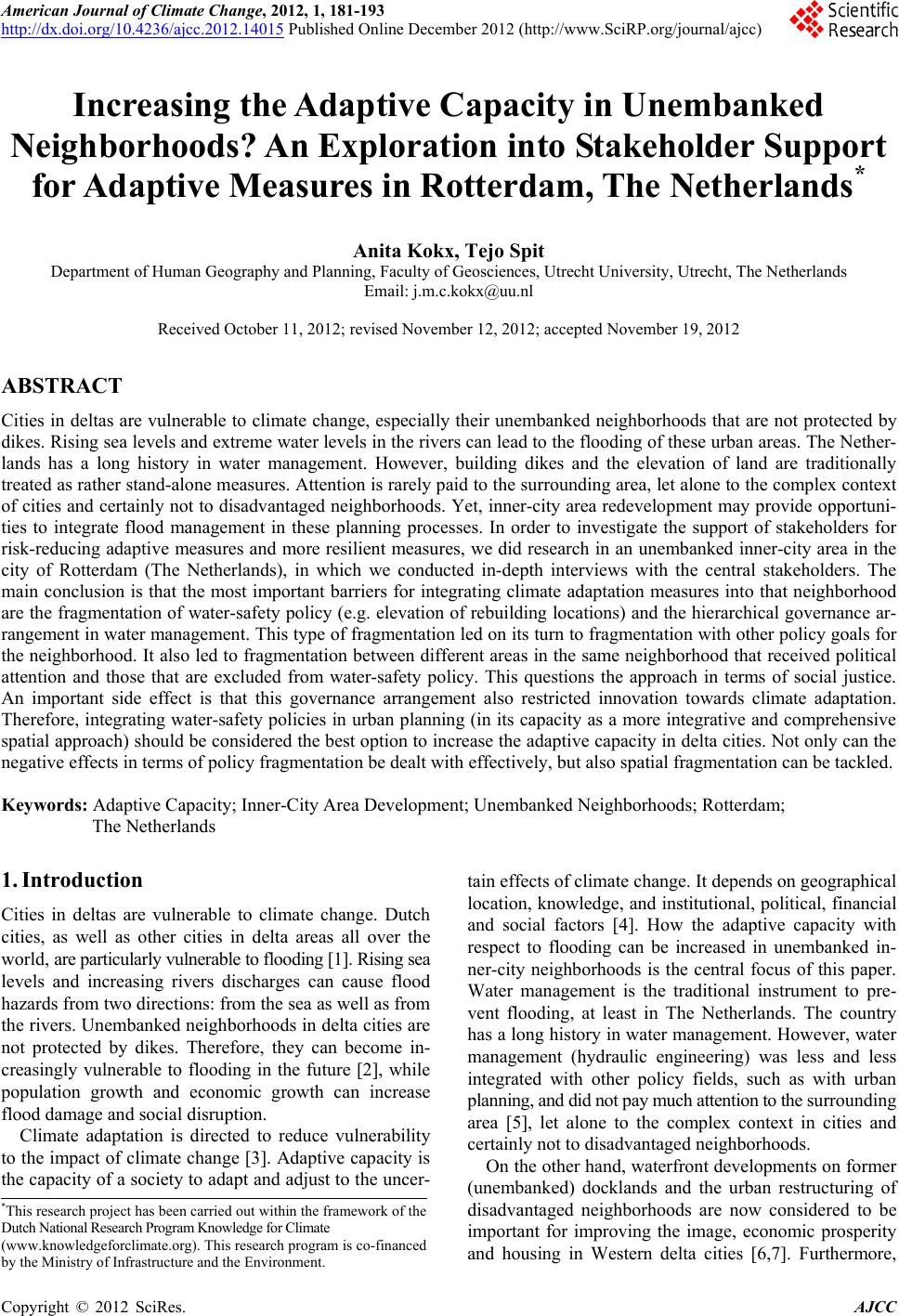 American Journal of Climate Change, 2012, 1, 181-193 http://dx.doi.org/10.4236/ajcc.2012.14015 Published Online December 2012 (http://www.SciRP.org/journal/ajcc) Increasing the Adaptive Capacity in Unembanked Neighborhoods? An Exploration into Stakeholder Support for Adaptive Measures in Rotterdam, The Netherlands* Anita Kokx, Tejo Spit Department of Human Geography and Planning, Faculty of Geosciences, Utrecht University, Utrecht, The Netherlands Email: j.m.c.kokx@uu.nl Received October 11, 2012; revised November 12, 2012; accepted November 19, 2012 ABSTRACT Cities in deltas are vulnerable to climate change, especially their unembanked neighborhoods that are not protected by dikes. Rising sea levels and extreme water levels in the rivers can lead to the flooding of these urban areas. The Nether- lands has a long history in water management. However, building dikes and the elevation of land are traditionally treated as rather stand-alone measures. Attention is rarely paid to the su rrounding area, let alone to the complex context of cities and certainly not to disadvan taged neighborhoods. Yet, inner-city area redevelopment may provide opportuni- ties to integrate flood management in these planning processes. In order to investigate the support of stakeholders for risk-reducing adaptive measures and more resilient measures, we did research in an unembanked inner-city area in the city of Rotterdam (The Netherlands), in which we conducted in-depth interviews with the central stakeholders. The main conclusion is that the most important barriers for integrating climate adaptation measures into that neighborhood are the fragmentation of wa ter-safety policy (e.g. elevation of rebuilding locations) and the hierarchical governance ar- rangement in water management. This type of fragmentation led on its turn to fragmentation with other po licy goals for the neighborhood. It also led to fragmentation between different areas in the same neighborhood that received political attention and those that are excluded from water-safety policy. This questions the approach in terms of social justice. An important side effect is that this governance arrangement also restricted innovation towards climate adaptation. Therefore, integrating water-safety policies in urban planning (in its capacity as a more integrative and comprehensive spatial approach ) should be considered th e best option to increase the adap tive capacity in delta cities. Not on ly can the negative effects in terms of policy fragmentation be dealt with effectively, but also spatial fragmentation can be tackled. Keywords: Adaptive Capacity; Inner-City Area Development; Unembanked Neighborhoods; Rotterdam; The Netherlands 1. Introduction Cities in deltas are vulnerable to climate change. Dutch cities, as well as other cities in delta areas all over the world, are particularly vulnerable to flooding [1]. Rising sea levels and increasing rivers discharges can cause flood hazards from two directions: from the sea as well as from the rivers. Unembanked neighborhoods in delta cities are not protected by dikes. Therefore, they can become in- creasingly vulnerable to flooding in the future [2], while population growth and economic growth can increase flood damage and social disruption. Climate adaptation is directed to reduce vulnerability to the impact of climate change [3]. Adaptive capacity is the capacity of a society to adapt and adjust to the uncer- tain effects of climate change. It depends on geographical location, knowledge, and institutional, political, financ ial and social factors [4]. How the adaptive capacity with respect to flooding can be increased in unembanked in- ner-city neighborhoods is the central focus of this paper. Water management is the traditional instrument to pre- vent flooding, at least in The Netherlands. The country has a long history in water management. However, water management (hydraulic engineering) was less and less integrated with other policy fields, such as with urban planning, and did not pay much attention to the surrounding area [5], let alone to the complex context in cities and certainly not to disadvantaged neighborhoods. On the other hand, waterfront developments on former (unembanked) docklands and the urban restructuring of disadvantaged neighborhoods are now considered to be important for improving the image, economic prosperity and housing in Western delta cities [6,7]. Furthermore, *This research project has been carried out within the framework of the Dutch National Research Pr ogram Knowledge for Climate (www.knowledgeforclimate.org). This research program is co-financed the Ministr of Infrastructure and the E nv ironment. C opyright © 2012 SciRes. AJCC 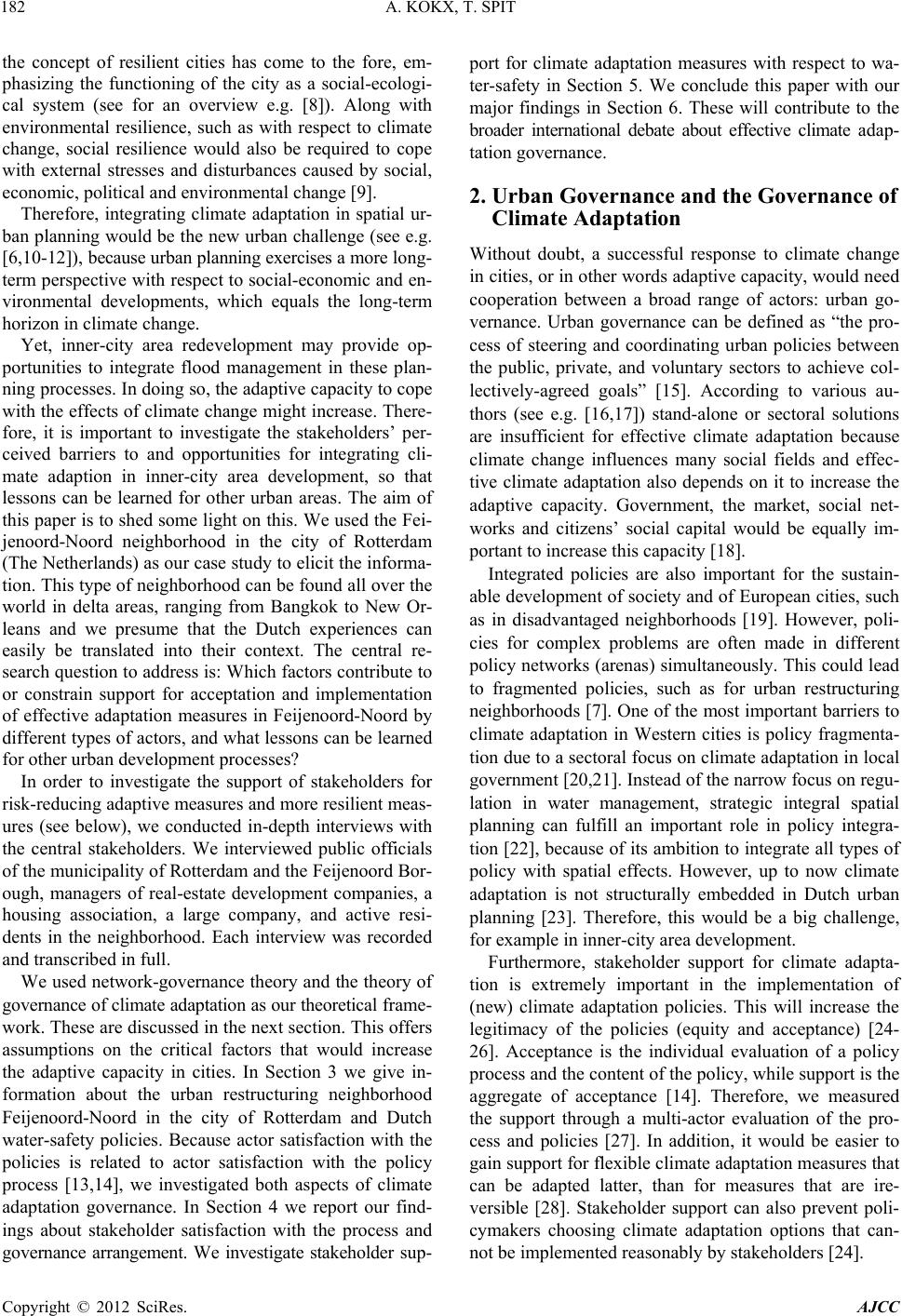 A. KOKX, T. SPIT 182 the concept of resilient cities has come to the fore, em- phasizing the functioning of the city as a social-ecologi- cal system (see for an overview e.g. [8]). Along with environmental resilience, such as with respect to climate change, social resilience would also be required to cope with external stresses and disturbances caused by social, economic, political and environmental change [9]. Therefore, integrating climate adaptation in spatial ur- ban planning would be the new urban challenge (see e.g. [6,10-12]), because urban planning exercises a more long- term perspective with respect to social-economic and en- vironmental developments, which equals the long-term horizon in climate change. Yet, inner-city area redevelopment may provide op- portunities to integrate flood management in these plan- ning processes. In doing so, the adaptive capacity to cope with the effects of climate change might increase. There- fore, it is important to investigate the stakeholders’ per- ceived barriers to and opportunities for integrating cli- mate adaption in inner-city area development, so that lessons can be learned for other urban areas. The aim of this paper is to shed some light on this. We used the Fei- jenoord-Noord neighborhood in the city of Rotterdam (The Netherlands) as our case study to elicit th e informa- tion. This type of neighborhood can be found all over the world in delta areas, ranging from Bangkok to New Or- leans and we presume that the Dutch experiences can easily be translated into their context. The central re- search question to address is: W hich factors contribute to or constrain support for acceptation and implementation of effective adaptation measures in Feijenoord-Noord by different types of actors, and what lessons can be learned for other ur ban de vel o pment processes ? In order to investigate the support of stakeholders for risk-reducing adaptive measures and more resilient meas- ures (see below), we conducted in-depth interviews with the central stakeholders. We interviewed public officials of the municipality of Rotterda m and the Feijenoord Bor- ough, managers of real-estate development companies, a housing association, a large company, and active resi- dents in the neighborhood. Each interview was recorded and transcribed in full. We used network-governance theory and the theory of governance of climate adaptation as our theoretical f ra me- work. These are discussed in the next section. This offers assumptions on the critical factors that would increase the adaptive capacity in cities. In Section 3 we give in- formation about the urban restructuring neighborhood Feijenoord-Noord in the city of Rotterdam and Dutch water-safety policies. Because actor satisfaction with the policies is related to actor satisfaction with the policy process [13,14], we investigated both aspects of climate adaptation governance. In Section 4 we report our find- ings about stakeholder satisfaction with the process and governance arrangement. We investigate stakeholder sup- port for climate adaptation measures with respect to wa- ter-safety in Section 5. We conclude this paper with our major findings in Section 6. These will contribute to the broader international debate about effective climate adap- tation governance. 2. Urban Governance and the Governance of Climate Adaptation Without doubt, a successful response to climate change in cities, or in other word s adaptive capacity, would need cooperation between a broad range of actors: urban go- vernance. Urban governance can be defined as “the pro- cess of steering and coordinating urban policies between the public, private, and voluntary sectors to achieve col- lectively-agreed goals” [15]. According to various au- thors (see e.g. [16,17]) stand-alone or sectoral solutions are insufficient for effective climate adaptation because climate change influences many social fields and effec- tive climate adaptation also depends on it to increase the adaptive capacity. Government, the market, social net- works and citizens’ social capital would be equally im- portant to increase this capacity [18]. Integrated policies are also important for the sustain- able development of society an d of European cities, such as in disadvantaged neighborhoods [19]. However, poli- cies for complex problems are often made in different policy networks (arenas) simultaneously. This could lead to fragmented policies, such as for urban restructuring neighborhoods [7]. One of the most important barriers to climate adaptation in Western cities is policy fragmenta- tion due to a sectoral focus on climate adaptation in local government [20,21]. Instead of the narrow focus on regu- lation in water management, strategic integral spatial planning can fulfill an important role in policy integra- tion [22], because of its ambition to integrate all types of policy with spatial effects. However, up to now climate adaptation is not structurally embedded in Dutch urban planning [23]. Therefore, this would be a big challenge, for example in inner-city area development. Furthermore, stakeholder support for climate adapta- tion is extremely important in the implementation of (new) climate adaptation policies. This will increase the legitimacy of the policies (equity and acceptance) [24- 26]. Acceptance is the individual evaluation of a policy process and the content of the p olicy, while sup po rt is the aggregate of acceptance [14]. Therefore, we measured the support through a multi-actor evaluation of the pro- cess and policies [27]. In addition, it would be easier to gain support for flexible cli mate adaptation measures that can be adapted latter, than for measures that are ire- versible [28]. Stakeholder support can also prevent poli- cymakers choosing climate adaptation options that can- not be implemented reasonably by stakeholders [24]. Copyright © 2012 SciRes. AJCC  A. KOKX, T. SPIT 183 2.1. Adaptive Governance Moreover, in governance processes resources (money, knowledge, information) can be shared between stake- holders [29]. This might also increase the adaptive capa- city [17,30,31]. Interactive iterativ e processes might lead to a shared vision on the policy problem and the best policy solution [2 9]. This might also lead to policy inno - vation [13], such as for climate adaptation [26,32,33]: adaptive governance. This implies that the policies should be flexible, so that new insights and circumstances can be taken into account and new actors can be involved [34]. Therefore, climate adaptation decision making must also be a flexible and dynamic process, in order to take uncertain climate change into account and to increase the adaptive capacity effectively [17,35-39]. However, Dutch urban restructuring practice—its in- flexibility, reflected in risk-avoiding behavior—is para- mount. It restricts policy innovation [7]. This can also be the case in our case study. Also, a lack of a sense of ur- gency to adapt to climate change can affect the adaptive capacity negatively, owing to a lack of social support [40] and lack of political will [41]. However, policy en- trepreneurs can generate policy change, especially by using “windows of opportunity” and their professional networks effectively [42,43], such as for climate adapta- tion [44] . Klijn and Koppenjan [45, p. 19] define policy net wor ks in public governance as “a (more or less) stable pattern of social relations between interdependent actors, which take shape around policy problems and/or policy pro- grammes.” Adaptive policy networks are sensitive and adaptive to their (policy) environment and can generate policy change. However, policy networks that are very closed are more or less insensitive to the multiple con- texts around them and are not op en to policy change [34]. We might expect an adaptive policy network in our case study, because this would deliver integrated policies (including water safety), and a sustainable joint-working capacity by sharing responsibilities and resources b et wee n local government, real-estate development companies, the housing associations and residents. 2.2. The Governance Arrangement The promises of normative network theory (inclusion, better policies and easier implementation by sharing re- sources: [29]) are not always fulfilled in practice, owing to conflicting pressures from networked, hierarchical and market forms of governance [7,46]. The institutional de- sign or governance arrangement (the inclusion/exclusion of actors; their degree of influence and the roles and tasks the actors have to fulfill) structures the cooperation process [47]. Therefore, the governance arrangement is extremely important for the actors’ satisfaction with the policy process and the policy content. The more they are satisfied with the process, the more they are satisfied with the policy content [13,14]. However, diverging per- ceptions or different frames of reference (ambiguity: [4 8]) regarding the roles and tasks between the public and pri- vate domains and the content of the policies can impair effective cooperation. Consequently, consensus among stakeholders about climate adaptation is not self-evident, owing to diverse values, beliefs, understandings, norms, policy cultures and so on [11]. Traditional hierarchical steering, for example, can hin- der horizontal cooperation, because insufficient attention can be paid to the specific local context and actors’ in- terests [7,46,49]. In sharp contrast to hierarchical uni- form regulation, climate adaptation should be a very con- text-specific process, with specific context-dependent cli- mate adaptation options [16,36]. Furthermore, under neo- liberalism, government can transfer the public costs of the policies to the market and their citizens. This can lead to boundary disputes between the public and private do- mains [50]. Consequently, disagreements about responsi- bilities decrease the capacity for cooperation in urban restructuring [7]. This can also be the case in our case study with respect to climate adaptation. In addition, involving the community in policy forma- tion might develop social capital and community cohe- sion, improve service delivery and meet local needs [51], such as in climate adaptation [52]. However, in practice residents often have a marginal role in strategic decision making for their neighborhood [7,51] and in climate ad ap - tation policies [21]. Therefore, the policies are often di- rected to meet the particular interests of the organizations involved, and not those of the residents [53]. Further- more, the manner in which climate adaptation is imple- mented directly questions the social justice in how the risks are divided in communities [18]. To summarize, the general barriers to integrating cli- mate adaptation in urban planning can be found in such factors as policy fragmentation, the lack of a sense of urgency, hierarchical steering, different frames of refer- ence and the exclusion of residents. 2.3. Barriers for Climate Adaptation in Cities In addition to these more general barriers, climate adap- tation in cities is not easy to ach ieve. For example, exist- ing spatial functions cannot be easily restricted or dis- placed [30]. Fragmented ownership and management of land and housing can also restrict opportunities for adap- tation [54]. In addition, many adaptation measures re- quire more land in public space or a less compact built environment [55]. Climate adaptation in cities can also be very expensive. Therefore climate adaptation can of- ten be implemented over a long time horizon, because Copyright © 2012 SciRes. AJCC 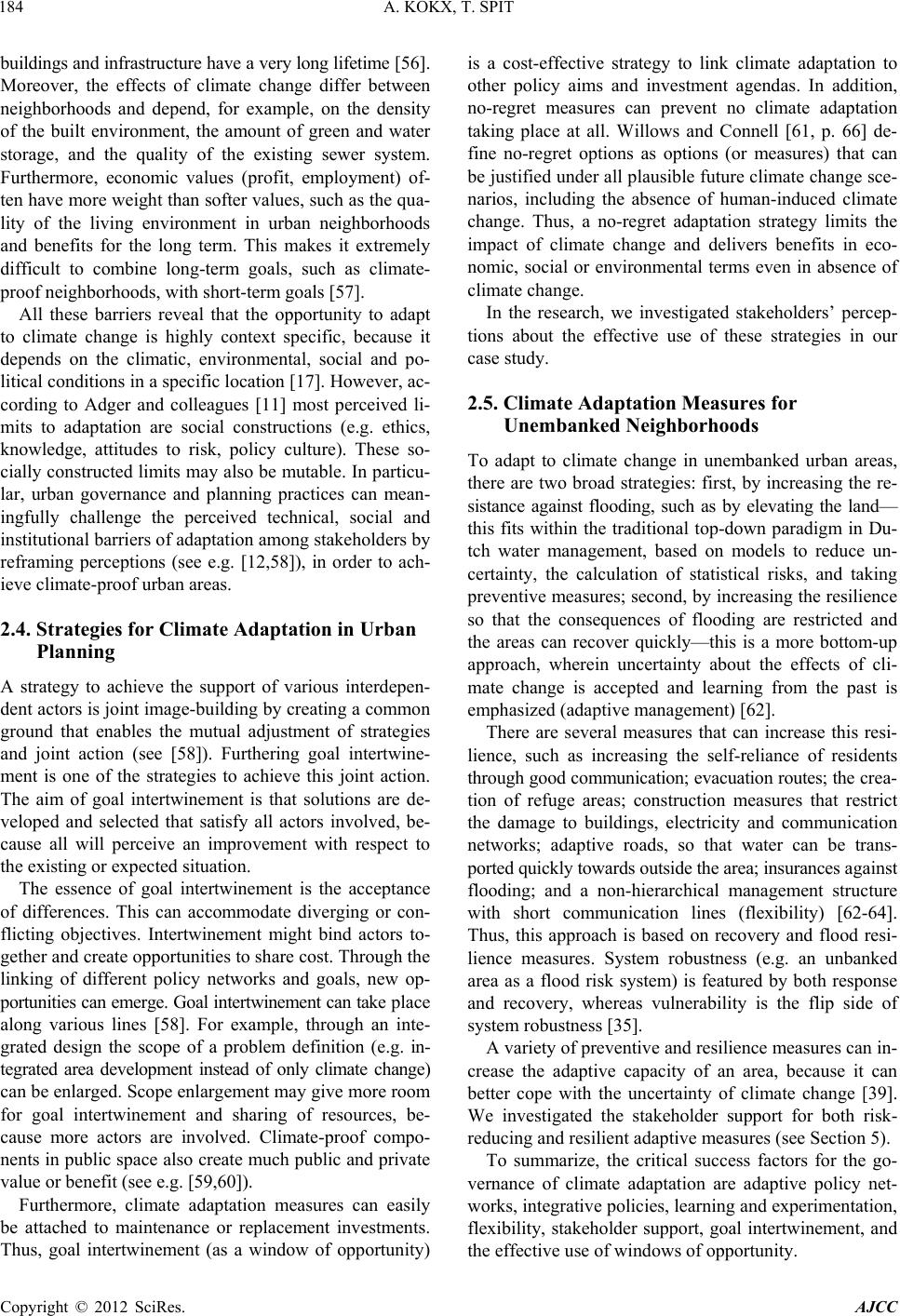 A. KOKX, T. SPIT 184 buildings and infrastructure have a very long lifetime [ 5 6 ]. Moreover, the effects of climate change differ between neighborhoods and depend, for example, on the density of the built environment, the amount of green and water storage, and the quality of the existing sewer system. Furthermore, economic values (profit, employment) of- ten have more weight than softer values, such as the qua- lity of the living environment in urban neighborhoods and benefits for the long term. This makes it extremely difficult to combine long-term goals, such as climate- proof neighbo rhoods, with short -t erm goals [57]. All these barriers reveal that the opportunity to adapt to climate change is highly context specific, because it depends on the climatic, environmental, social and po- litical conditions in a specific location [17]. However, ac- cording to Adger and colleagues [11] most perceived li- mits to adaptation are social constructions (e.g. ethics, knowledge, attitudes to risk, policy culture). These so- cially constructed limits may also be mutable. In particu- lar, urban governance and planning practices can mean- ingfully challenge the perceived technical, social and institutional barriers of adaptation among stakeholders by reframing perceptions (see e.g. [12,58]), in order to ach- ieve climate-proof urban areas. 2.4. Strategies for Climate Adaptation in Urban Planning A strategy to achieve the support of various interdepen- dent actors is joint image-building by creating a common ground that enables the mutual adjustment of strategies and joint action (see [58]). Furthering goal intertwine- ment is one of the strategies to achieve this joint action. The aim of goal intertwinement is that solutions are de- veloped and selected that satisfy all actors involved, be- cause all will perceive an improvement with respect to the existing or expected situation. The essence of goal intertwinement is the acceptance of differences. This can accommodate diverging or con- flicting objectives. Intertwinement might bind actors to- gether and create opportunities to sh are cost. Th rough th e linking of different policy networks and goals, new op- portunities can emerge. Goal intertwinement can take p la ce along various lines [58]. For example, through an inte- grated design the scope of a problem definition (e.g. in- tegrated area development instead of only climate change) can be enlarged. Scope enlargement may give more room for goal intertwinement and sharing of resources, be- cause more actors are involved. Climate-proof compo- nents in public space also create much public and private value or benefit (see e.g. [59,60]). Furthermore, climate adaptation measures can easily be attached to maintenance or replacement investments. Thus, goal intertwinement (as a window of opportunity) is a cost-effective strategy to link climate adaptation to other policy aims and investment agendas. In addition, no-regret measures can prevent no climate adaptation taking place at all. Willows and Connell [61, p. 66] de- fine no-regret options as options (or measures) that can be justified under all plausible future climate change sce- narios, including the absence of human-induced climate change. Thus, a no-regret adaptation strategy limits the impact of climate change and delivers benefits in eco- nomic, social or environmental terms even in absence of climate change. In the research, we investigated stakeholders’ percep- tions about the effective use of these strategies in our case study. 2.5. Climate Adaptation Measures for Unembanked Neighborhoods To adapt to climate change in unembanked urban areas, there are two broad strategies: first, by increasing the re- sistance against flooding, such as by elevating the land— this fits within the traditional top-down paradigm in Du- tch water management, based on models to reduce un- certainty, the calculation of statistical risks, and taking preventiv e measures; second, by in creasing the resilience so that the consequences of flooding are restricted and the areas can recover quickly—this is a more bottom-up approach, wherein uncertainty about the effects of cli- mate change is accepted and learning from the past is emphasized (adaptive management) [62]. There are several measures that can increase this resi- lience, such as increasing the self-reliance of residents through good communication; evacuation routes; the cr ea- tion of refuge areas; construction measures that restrict the damage to buildings, electricity and communication networks; adaptive roads, so that water can be trans- ported quickly towards outsi de the area; insurances against flooding; and a non-hierarchical management structure with short communication lines (flexibility) [62-64]. Thus, this approach is based on recovery and flood resi- lience measures. System robustness (e.g. an unbanked area as a flood risk system) is featured by both response and recovery, whereas vulnerability is the flip side of system robustness [35]. A variety of preventive and resilience measures can in- crease the adaptive capacity of an area, because it can better cope with the uncertainty of climate change [39]. We investigated the stakeholder support for both risk- reducing and resilient adaptive measures (see Section 5). To summarize, the critical success factors for the go- vernance of climate adaptation are adaptive policy net- works, integrative policies, learning and experimentatio n, flexibility, stakeholder support, goal intertwinement, and the effective use of windows of opportunity. Copyright © 2012 SciRes. AJCC 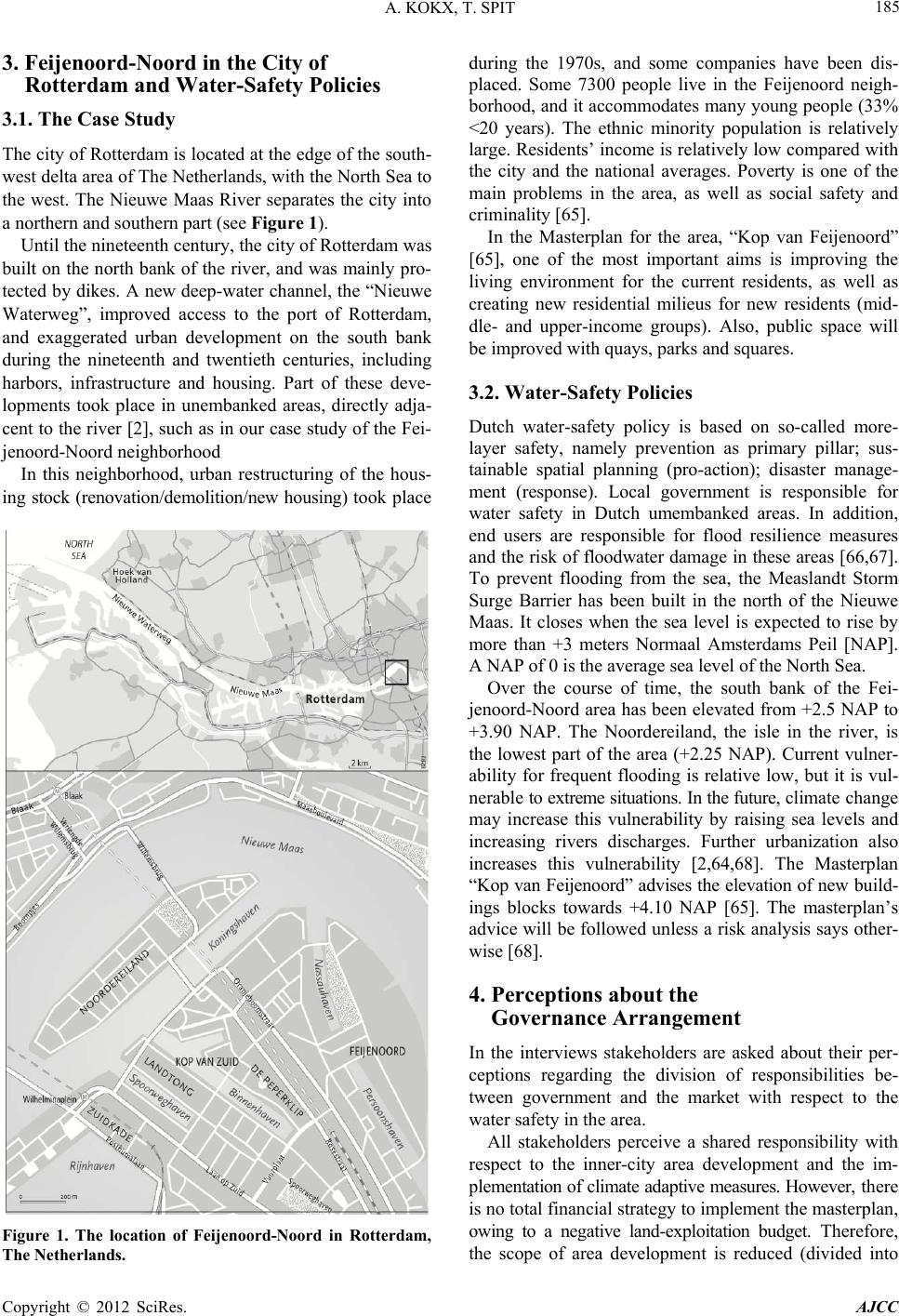 A. KOKX, T. SPIT 185 3. Feijenoord-Noord in the City of Rotterdam and Water-Safety Policies 3.1. The Case Study The city of Rotterdam is located at the edge of the south- west delta area of The Netherlands, with the North Sea to the west. The Nieuwe Maas River separates the city into a northern and southern part (see Figure 1). Until the nineteenth century, the city of Rotterdam was built on the north bank of the river, and was mainly pro- tected by dikes. A new deep-water channel, the “Nieuwe Waterweg”, improved access to the port of Rotterdam, and exaggerated urban development on the south bank during the nineteenth and twentieth centuries, including harbors, infrastructure and housing. Part of these deve- lopments took place in unembanked areas, directly adja- cent to the river [2], such as in our case study of the Fei- jenoord-Noord neighborhood In this neighborhood, urban restructuring of the hous- ing stock (renovation/demolition/new housing) took place Figure 1. The location of Feijenoord-Noord in Rotterdam, The Netherlands. during the 1970s, and some companies have been dis- placed. Some 7300 people live in the Feijenoord neigh- borhood, and it accommodates many young people (33% <20 years). The ethnic minority population is relatively large. Residents’ income is relatively low compared with the city and the national averages. Poverty is one of the main problems in the area, as well as social safety and criminality [65]. In the Masterplan for the area, “Kop van Feijenoord” [65], one of the most important aims is improving the living environment for the current residents, as well as creating new residential milieus for new residents (mid- dle- and upper-income groups). Also, public space will be improved with quays, parks and squares. 3.2. Water-Safety Policies Dutch water-safety policy is based on so-called more- layer safety, namely prevention as primary pillar; sus- tainable spatial planning (pro-action); disaster manage- ment (response). Local government is responsible for water safety in Dutch umembanked areas. In addition, end users are responsible for flood resilience measures and the risk of floodwater damage in these areas [66,67]. To prevent flooding from the sea, the Measlandt Storm Surge Barrier has been built in the north of the Nieuwe Maas. It closes when the sea level is expected to rise by more than +3 meters Normaal Amsterdams Peil [NAP]. A NAP of 0 is the average sea level of the North Sea. Over the course of time, the south bank of the Fei- jenoord-No ord area has been elevated from +2.5 NAP to +3.90 NAP. The Noordereiland, the isle in the river, is the lowest part of the area (+2.25 NAP). Current vulner- ability for frequent flooding is relative low, but it is vul- nerable to extreme situations. In the future, climate change may increase this vulnerability by raising sea levels and increasing rivers discharges. Further urbanization also increases this vulnerability [2,64,68]. The Masterplan “Kop van Feijenoord” advises the elevation of new bu ild- ings blocks towards +4.10 NAP [65]. The masterplan’s advice will be followed unless a risk analysis says other- wise [68]. 4. Perceptions about the Governance Arrangement In the interviews stakeholders are asked about their per- ceptions regarding the division of responsibilities be- tween government and the market with respect to the water safety in the area. All stakeholders perceive a shared responsibility with respect to the inner-city area development and the im- plementation of climate adaptive measures. However, t h er e is no total financial strategy to implement the masterplan, owing to a negative land-exploitation budget. Therefore, the scope of area development is reduced (divided into Copyright © 2012 SciRes. AJCC 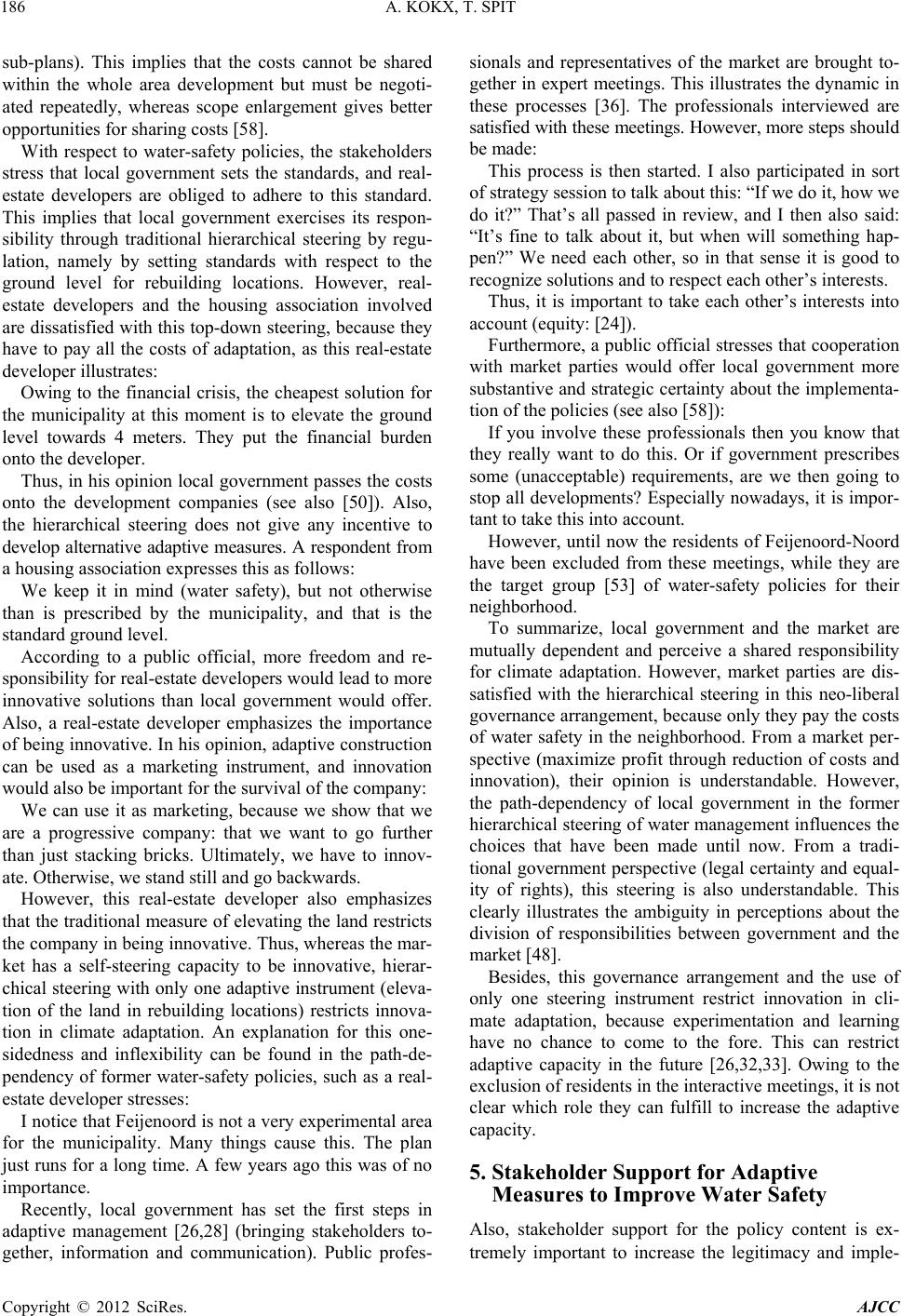 A. KOKX, T. SPIT 186 sub-plans). This implies that the costs cannot be shared within the whole area development but must be negoti- ated repeatedly, whereas scope enlargement gives better opportunities for sharing costs [58]. With respect to water-safety policies, the stakeholders stress that local government sets the standards, and real- estate developers are obliged to adhere to this standard. This implies that local government exercises its respon- sibility through traditional hierarchical steering by regu- lation, namely by setting standards with respect to the ground level for rebuilding locations. However, real- estate developers and the housing association involved are dissatisfied with this top-down steering, because they have to pay all the costs of adaptation, as this real-estate developer illustrates: Owing to the financial crisis, the cheapest solution for the municipality at this moment is to elevate the ground level towards 4 meters. They put the financial burden onto the developer. Thus, in his opinion local gover nment passes the costs onto the development companies (see also [50]). Also, the hierarchical steering does not give any incentive to develop alternative adaptive measures. A respondent fr om a housing association ex presses this as follows: We keep it in mind (water safety), but not otherwise than is prescribed by the municipality, and that is the standard ground level. According to a public official, more freedom and re- sponsibility for real-estate developers would lead to more innovative solutions than local government would offer. Also, a real-estate developer emphasizes the importance of being innovativ e. In his opinion, adap tive constru ction can be used as a marketing instrument, and innovation would also be important for the survival of the company: We can use it as marketing, because we show that we are a progressive company: that we want to go further than just stacking bricks. Ultimately, we have to innov- ate. Otherwise, we stand still and go backwards. However, this real-estate developer also emphasizes that the traditional measure of elevating the land restricts the company in being innovative. Thus, whereas the mar- ket has a self-steering capacity to be innovative, hierar- chical steering with only one adaptive instrument (eleva- tion of the land in rebuilding locations) restricts innova- tion in climate adaptation. An explanation for this one- sidedness and inflexibility can be found in the path-de- pendency of former water-safety policies, such as a real- estate developer stresses: I notice that Feijenoord is no t a very experimental area for the municipality. Many things cause this. The plan just runs for a long time. A few years ago this was of no importance. Recently, local government has set the first steps in adaptive management [26,28] (bringing stakeholders to- gether, information and communication). Public profes- sionals and representatives of the market are brought to- gether in exp ert meetings. This illustrates the d ynamic in these processes [36]. The professionals interviewed are satisfied with these meetings. However, more steps shou ld be made: This process is then started. I also participated in sort of strategy session to talk about this: “If we do it, how we do it?” That’s all passed in review, and I then also said: “It’s fine to talk about it, but when will something hap- pen?” We need each other, so in that sense it is good to recognize solutions and to respect each other’s interests. Thus, it is important to take each other’s interests into account (equity: [24]). Furthermore, a public official stresses that cooperation with market parties would offer local government more substantive and strateg ic certainty about the i mplementa- tion of the policies (see also [58]): If you involve these professionals then you know that they really want to do this. Or if government prescribes some (unacceptable) requirements, are we then going to stop all developments? Especially nowadays, it is impor- tant to take this in to account. However, until now the residents of Feijenoord-Noord have been excluded from these meetings, while they are the target group [53] of water-safety policies for their neighborhood. To summarize, local government and the market are mutually dependent and perceive a shared responsibility for climate adaptation. However, market parties are dis- satisfied with the hierarchical steering in this neo-liberal governance arrangement, because only they pay the costs of water safety in the neighborhood. From a market per- spective (maximize profit through reduction of costs and innovation), their opinion is understandable. However, the path-dependency of local government in the former hierarchical steering of water management influences the choices that have been made until now. From a tradi- tional government perspective (legal certainty and equal- ity of rights), this steering is also understandable. This clearly illustrates the ambiguity in perceptions about the division of responsibilities between government and the market [48]. Besides, this governance arrangement and the use of only one steering instrument restrict innovation in cli- mate adaptation, because experimentation and learning have no chance to come to the fore. This can restrict adaptive capacity in the future [26,32,33]. Owing to the exclusion of residents in the interactive meeting s, it is not clear which role they can fulfill to increase the adaptive capacity. 5. Stakeholder Support for Adaptive Measures to Improve Water Safety Also, stakeholder support for the policy content is ex- tremely important to increase the legitimacy and imple- Copyright © 2012 SciRes. AJCC 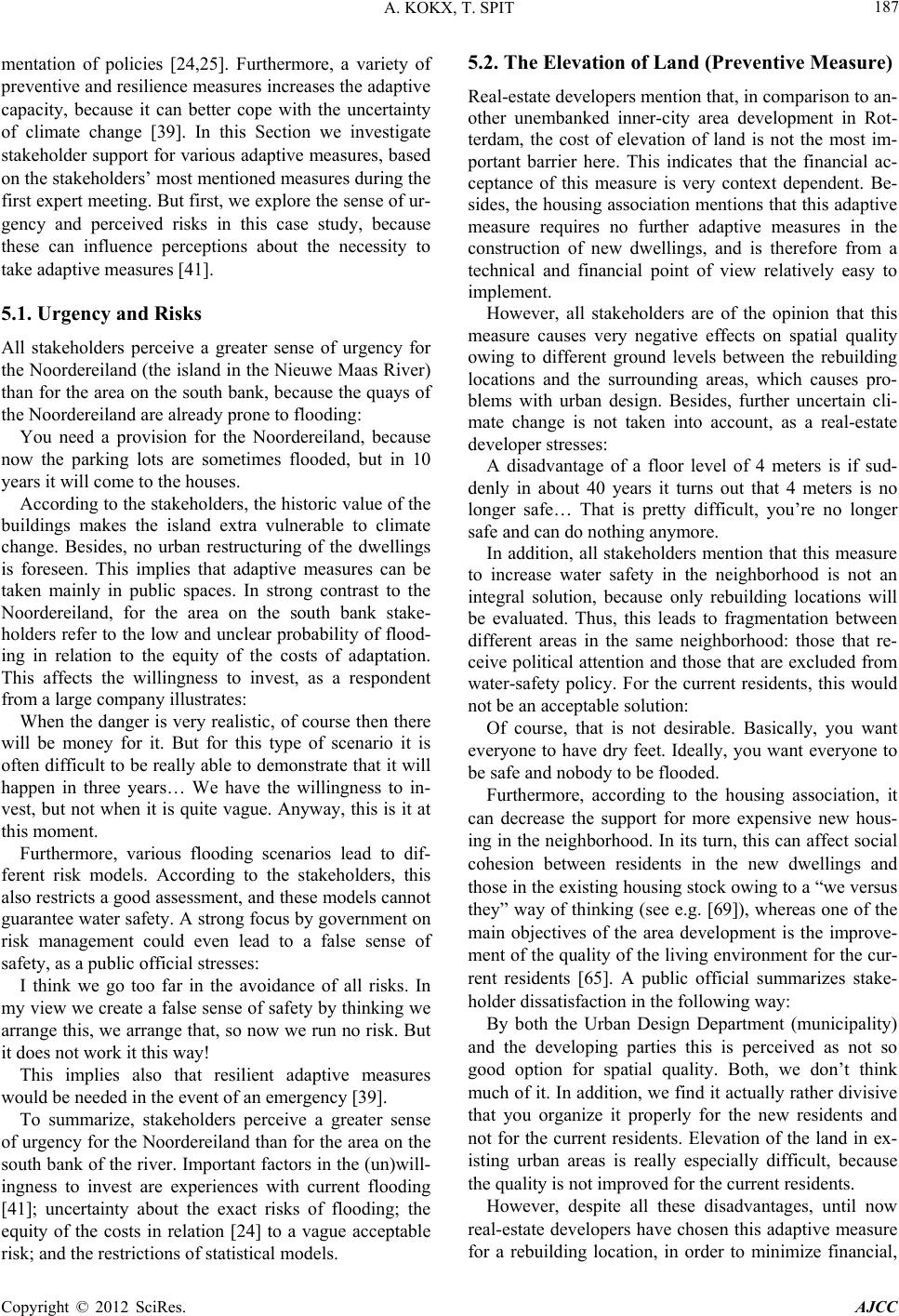 A. KOKX, T. SPIT 187 mentation of policies [24,25]. Furthermore, a variety of preventiv e and resilience measures in creases the adap tive capacity, because it can better cope with the uncertainty of climate change [39]. In this Section we investigate stakeholder support for various adaptive measures, based on the stakeholders’ most mentioned measures during the first expert meeting. But first, we explore the sense of ur- gency and perceived risks in this case study, because these can influence perceptions about the necessity to take adaptive measures [41]. 5.1. Urgency and Risks All stakeholders perceive a greater sense of urgency for the Noordereiland (the island in the Nieuwe Maas River) than for the area on the south bank, because the quays of the Noordere iland are already prone to flooding: You need a provision for the Noordereiland, because now the parking lots are sometimes flooded, but in 10 years it will come to the houses. According to the stakeholders, the historic value of the buildings makes the island extra vulnerable to climate change. Besides, no urban restructuring of the dwellings is foreseen. This implies that adaptive measures can be taken mainly in public spaces. In strong contrast to the Noordereiland, for the area on the south bank stake- holders refer to the low and unclear probability of flood- ing in relation to the equity of the costs of adaptation. This affects the willingness to invest, as a respondent from a large company illustrates: When the danger is very realistic, of course then there will be money for it. But for this type of scenario it is often difficult to be really able to demonstrate that it will happen in three years… We have the willingness to in- vest, but not when it is quite vague. Anyway, this is it at this moment. Furthermore, various flooding scenarios lead to dif- ferent risk models. According to the stakeholders, this also restricts a good assessment, and these models cannot guarantee water safety. A strong focus by government on risk management could even lead to a false sense of safety, as a public official stresses: I think we go too far in the avoidance of all risks. In my view we create a false sense of safety by thinking we arrange this, we arrange that, so now we run no risk . But it does not work it this way! This implies also that resilient adaptive measures would be needed in the event of an emergency [39]. To summarize, stakeholders perceive a greater sense of urgency for the Noordereiland than for the area on the south bank of the river. Important factors in the (un)will- ingness to invest are experiences with current flooding [41]; uncertainty about the exact risks of flooding; the equity of the costs in relation [24] to a vague acceptable risk; and the restrictions of statistical mode ls. 5.2. The Elevation of Land (Preventive Measure) Real-estate developers mention that, in comparison to an- other unembanked inner-city area development in Rot- terdam, the cost of elevation of land is not the most im- portant barrier here. This indicates that the financial ac- ceptance of this measure is very context dependent. Be- sides, the housing asso ciation mentions that this adaptive measure requires no further adaptive measures in the construction of new dwellings, and is therefore from a technical and financial point of view relatively easy to implement. However, all stakeholders are of the opinion that this measure causes very negative effects on spatial quality owing to different ground levels between the rebuilding locations and the surrounding areas, which causes pro- blems with urban design. Besides, further uncertain cli- mate change is not taken into account, as a real-estate developer stresses: A disadvantage of a floor level of 4 meters is if sud- denly in about 40 years it turns out that 4 meters is no longer safe… That is pretty difficult, you’re no longer safe and can do nothing anymore. In addition, all stakeholders mention that this measure to increase water safety in the neighborhood is not an integral solution, because only rebuilding locations will be evaluated. Thus, this leads to fragmentation between different areas in the same neighborhood: those that re- ceive political attention and those that are excluded fro m water-safety policy. For the current residents, this would not be an acceptable solution: Of course, that is not desirable. Basically, you want everyone to have dry feet. Ideally, you want everyone to be safe and nobody to be flooded. Furthermore, according to the housing association, it can decrease the support for more expensive new hous- ing in the neighbor hood. In its turn, this can affect social cohesion between residents in the new dwellings and those in the existing hou sing stock owing to a “we versu s they” way of thinking (see e.g. [69]), whereas one of the main objectives of the area development is the improve- ment of the quality of the liv ing environment for the cur- rent residents [65]. A public official summarizes stake- holder dissatisfaction in the following way: By both the Urban Design Department (municipality) and the developing parties this is perceived as not so good option for spatial quality. Both, we don’t think much of it. In addition, we find it actually rather divisiv e that you organize it properly for the new residents and not for the current residents. Elevation of the land in ex- isting urban areas is really especially difficult, because the quality is not improved for the current residents. However, despite all these disadvantages, until now real-estate developers have chosen this adaptive measure for a rebuilding location, in order to minimize financial, Copyright © 2012 SciRes. AJCC 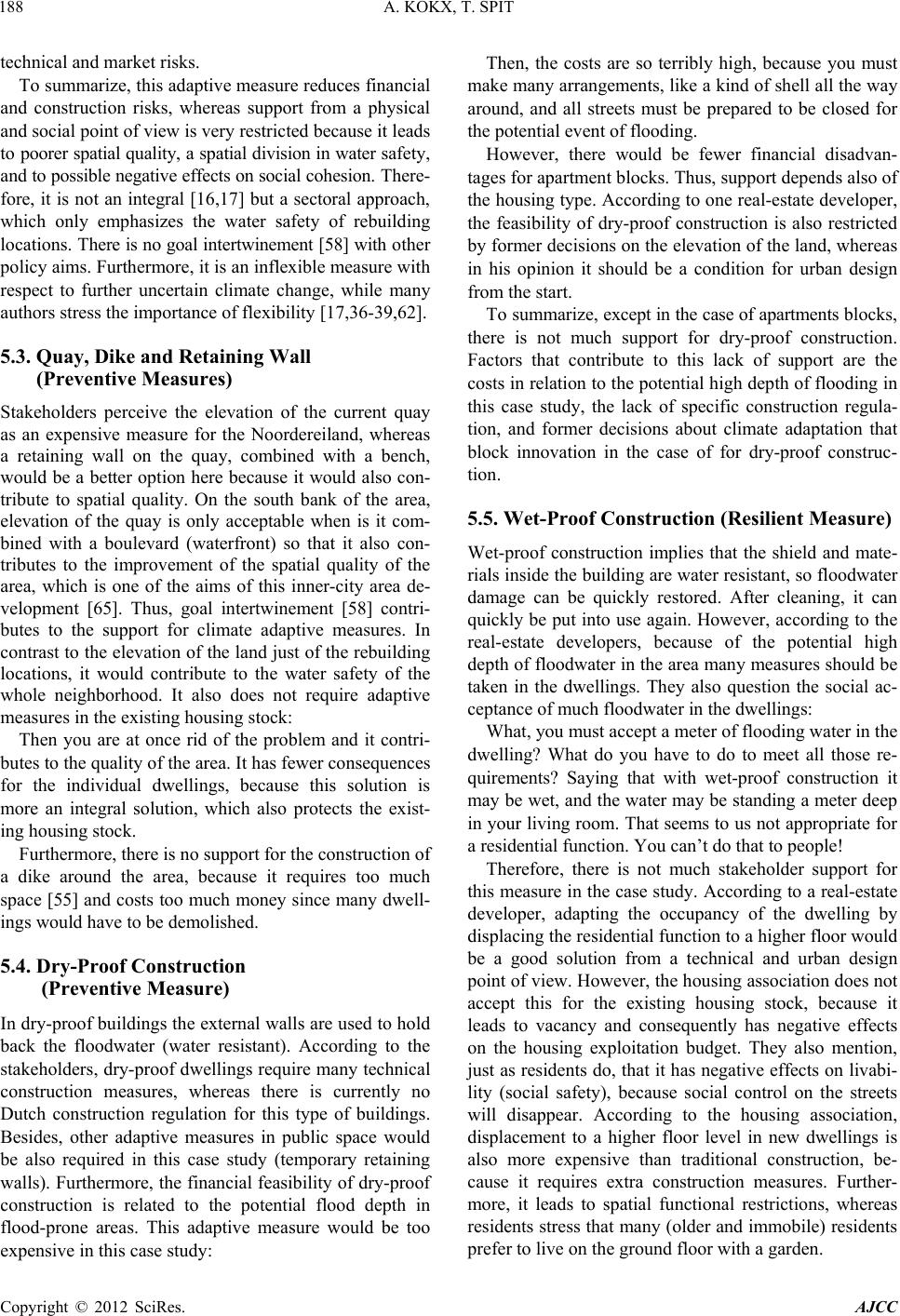 A. KOKX, T. SPIT 188 technical and market risks. To summarize, this adaptive measure reduces financial and construction risks, whereas support from a physical and social point of view is very restricted because it leads to poorer spatial quality, a spatial division in water saf ety, and to possible negative effects on social cohesion. T her e- fore, it is not an integral [16,17] but a sectoral approach, which only emphasizes the water safety of rebuilding loc atio ns. There is no goal intertwinement [58] with oth er policy aims. Furthermore, it is an inflexible measure with respect to further uncertain climate change, while many authors stress the importance of flexibility [17,36-39,62]. 5.3. Quay, Dike and Retaining Wall (Preventive Measures) Stakeholders perceive the elevation of the current quay as an expensive measure for the Noordereiland, whereas a retaining wall on the quay, combined with a bench, would be a better option here because it would also con- tribute to spatial quality. On the south bank of the area, elevation of the quay is only acceptable when is it com- bined with a boulevard (waterfront) so that it also con- tributes to the improvement of the spatial quality of the area, which is one of the aims of this inner-city area de- velopment [65]. Thus, goal intertwinement [58] contri- butes to the support for climate adaptive measures. In contrast to the elevation of the land just of the rebuilding locations, it would contribute to the water safety of the whole neighborhood. It also does not require adaptive measures in the existing housing stock: Then you are at once rid of the problem and it contri- butes to the quality of the area. It has fewer consequences for the individual dwellings, because this solution is more an integral solution, which also protects the exist- ing housin g sto ck. Furthermore, there is no support for the construction of a dike around the area, because it requires too much space [55] and costs too much money since many dwell- ings would have to be demol i shed . 5.4. Dry-Proof Construction (Preventive Measure) In dry-proof buildings the extern al walls are used to hold back the floodwater (water resistant). According to the stakeholders, dry-proof dwellings require many technical construction measures, whereas there is currently no Dutch construction regulation for this type of buildings. Besides, other adaptive measures in public space would be also required in this case study (temporary retaining walls). Furthermore, the financial feasibility of dry-pro of construction is related to the potential flood depth in flood-prone areas. This adaptive measure would be too expensive in this case study: Then, the costs are so terribly high, because you must make many arrangements, like a kind of shell all the way around, and all streets must be prepared to be closed for the potential even t of flooding . However, there would be fewer financial disadvan- tages for apartment blocks. Thus, support depends also of the housing type. According to one real-estate developer, the feasibility of dry-proof construction is also restricted by former decisions on the elevation of the land, whereas in his opinion it should be a condition for urban design from the start. To su mma riz e, except in the case of apartments b lo ck s, there is not much support for dry-proof construction. Factors that contribute to this lack of support are the costs in relation to th e potential high depth of flooding in this case study, the lack of specific construction regula- tion, and former decisions about climate adaptation that block innovation in the case of for dry-proof construc- tion. 5.5. Wet-Proof Construction (Resilient Measure) Wet-proof construction implies that the shield and mate- rials inside the building are water resistant, so floodwater damage can be quickly restored. After cleaning, it can quickly be put into use again. However, according to the real-estate developers, because of the potential high depth of floodwater in the area many measur es should be taken in the dwellings. They also question the social ac- ceptance of much floodwater in the dwellings: What, you must accept a meter of flooding water in the dwelling? What do you have to do to meet all those re- quirements? Saying that with wet-proof construction it may be wet, and the water may b e standing a meter deep in your living roo m. That seems to us not appropriate for a residential function. You can’t do that to people! Therefore, there is not much stakeholder support for this measure in the case study. According to a real-estate developer, adapting the occupancy of the dwelling by displacing the residential function to a higher floor would be a good solution from a technical and urban design point of view. However, the housing association does not accept this for the existing housing stock, because it leads to vacancy and consequently has negative effects on the housing exploitation budget. They also mention, just as residents do, that it has negative effects on livabi- lity (social safety), because social control on the streets will disappear. According to the housing association, displacement to a higher floor level in new dwellings is also more expensive than traditional construction, be- cause it requires extra construction measures. Further- more, it leads to spatial functional restrictions, whereas residents stress that many (older and immobile) residents prefer to live on the ground floor with a garden. Copyright © 2012 SciRes. AJCC 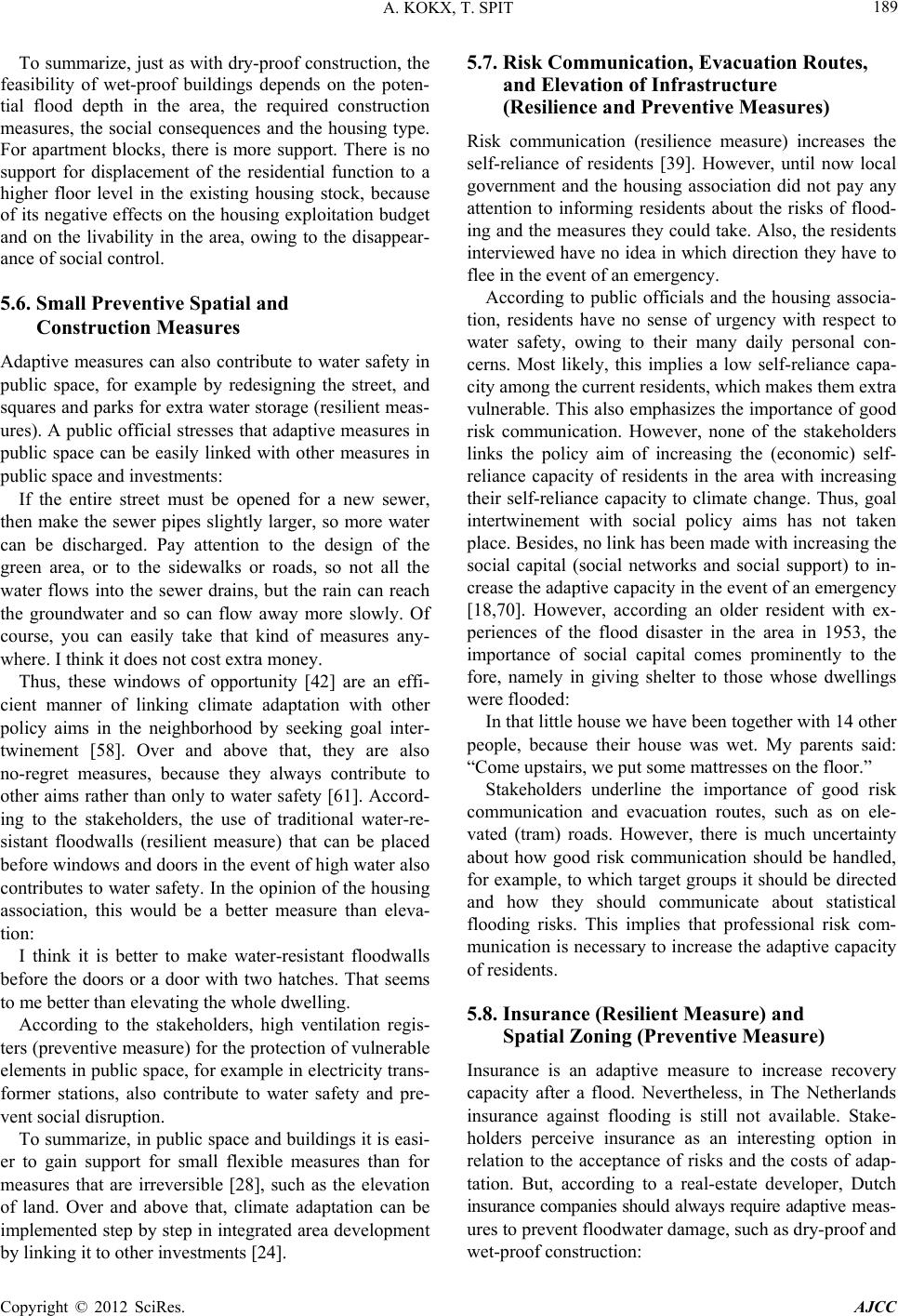 A. KOKX, T. SPIT 189 To summarize, just as with dry-proof constru ction, the feasibility of wet-proof buildings depends on the poten- tial flood depth in the area, the required construction measures, the social consequences and the housing type. For apartment blocks, there is more support. There is no support for displacement of the residential function to a higher floor level in the existing housing stock, because of its negative effects on the housing exploitation budget and on the livability in the area, owing to the disappear- ance of social control. 5.6. Small Preventive Spatial and Construction Measures Adaptive measures can also contribute to water safety in public space, for example by redesigning the street, and squares and parks for extra water storage (resilient meas- ures). A public official stresses that adaptive measures in public space can be easily linked with other measures in public space and investments: If the entire street must be opened for a new sewer, then make the sewer pipes slightly larger, so more water can be discharged. Pay attention to the design of the green area, or to the sidewalks or roads, so not all the water flows into the sewer drains, but the rain can reach the groundwater and so can flow away more slowly. Of course, you can easily take that kind of measures any- where. I think it does not cost extra money. Thus, these windows of opportunity [42] are an effi- cient manner of linking climate adaptation with other policy aims in the neighborhood by seeking goal inter- twinement [58]. Over and above that, they are also no-regret measures, because they always contribute to other aims rather than only to water safety [61]. Accord- ing to the stakeholders, the use of traditional water-re- sistant floodwalls (resilient measure) that can be placed before windows and doors in the event of high water also contributes to water safety. In the opin ion of the housing association, this would be a better measure than eleva- tion: I think it is better to make water-resistant floodwalls before the doors or a door with two hatches. That seems to me better than elevating the whole dwelling. According to the stakeholders, high ventilation regis- ters (preventive measure) for the protection of vulnerable elements in public space, for example in electricity trans- former stations, also contribute to water safety and pre- vent social disrupt io n. To summarize, in public space and buildings it is easi- er to gain support for small flexible measures than for measures that are irreversible [28], such as the elevation of land. Over and above that, climate adaptation can be implemented step by step in integrated area development by linking it to other investments [24]. 5.7. Risk Communication, Evacuation Routes, and Elevation of Infrastructure (Resilience and Preventive Measures) Risk communication (resilience measure) increases the self-reliance of residents [39]. However, until now local government and the housing association did not pay any attention to informing residents about the risks of flood- ing and the me asures they cou ld take. Also, the res idents interviewed have no id ea in which direction they have to flee in the event of an emergency. According to public officials and the housing associa- tion, residents have no sense of urgency with respect to water safety, owing to their many daily personal con- cerns. Most likely, this implies a low self-reliance capa- city among the current residents, which makes them extra vulnerable. This also emphasizes the importance of good risk communication. However, none of the stakeholders links the policy aim of increasing the (economic) self- reliance capacity of residents in the area with increasing their self-reliance capacity to climate change. Thus, goal intertwinement with social policy aims has not taken place. Besides, no link has been made with increasing the social capital (social networks and social support) to in- crease the adaptive capacity in the event of an emergency [18,70]. However, according an older resident with ex- periences of the flood disaster in the area in 1953, the importance of social capital comes prominently to the fore, namely in giving shelter to those whose dwellings were flooded: In that little house we have been together with 14 other people, because their house was wet. My parents said: “Come upstairs, we put some mattresses on the floor.” Stakeholders underline the importance of good risk communication and evacuation routes, such as on ele- vated (tram) roads. However, there is much uncertainty about how good risk communication should be handled, for example, to which target groups it should be directed and how they should communicate about statistical flooding risks. This implies that professional risk com- munication is necessary to increase the adaptive capacity of residents. 5.8. Insurance (Resilient Measure) and Spatial Zoning (Preventive Measure) Insurance is an adaptive measure to increase recovery capacity after a flood. Nevertheless, in The Netherlands insurance against flooding is still not available. Stake- holders perceive insurance as an interesting option in relation to the acceptance of risks and the costs of adap- tation. But, according to a real-estate developer, Dutch insurance co mpanies should always require adaptive mea s- ures to prevent flo odwater damage, such as dry-proof and wet-proof construction: Copyright © 2012 SciRes. AJCC 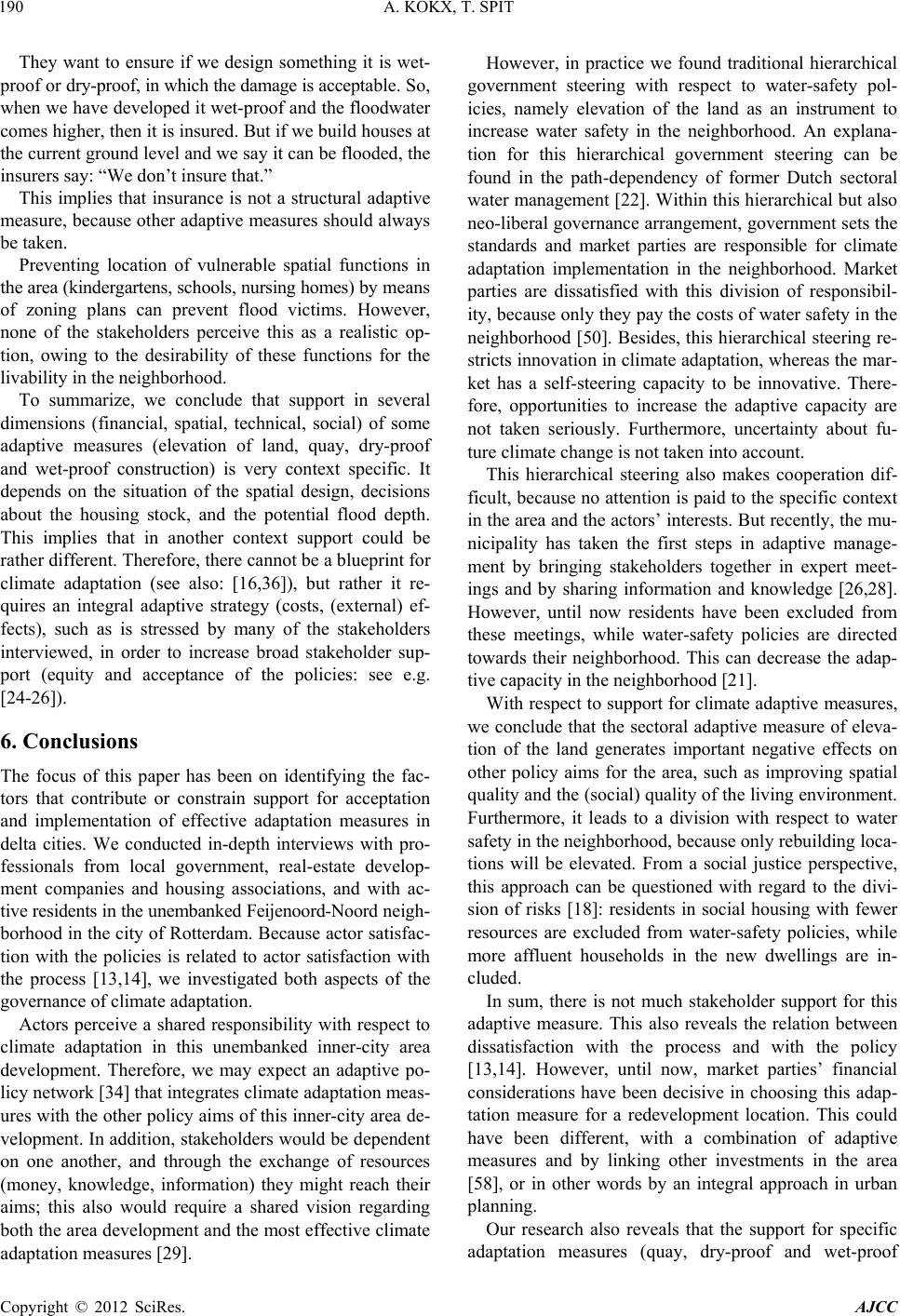 A. KOKX, T. SPIT 190 They want to ensure if we design something it is wet- pro of o r d ry-proof, in which the da mage is accepta ble . S o , when we have developed it wet-proof and the floodwater comes higher, then it is insured . But if we build houses at the current ground level and we say it can be flooded, the insurers say: “We don’t insure that.” This implies that insurance is not a structural adaptive measure, because other adaptive measures should always be taken. Preventing location of vulnerable spatial functions in the area (kindergartens, schools, nursing homes) by mean s of zoning plans can prevent flood victims. However, none of the stakeholders perceive this as a realistic op- tion, owing to the desirability of these functions for the livability in the neighborhood. To summarize, we conclude that support in several dimensions (financial, spatial, technical, social) of some adaptive measures (elevation of land, quay, dry-proof and wet-proof construction) is very context specific. It depends on the situation of the spatial design, decisions about the housing stock, and the potential flood depth. This implies that in another context support could be rather different. Therefore, there cannot be a blueprint for climate adaptation (see also: [16,36]), but rather it re- quires an integral adaptive strategy (costs, (external) ef- fects), such as is stressed by many of the stakeholders interviewed, in order to increase broad stakeholder sup- port (equity and acceptance of the policies: see e.g. [24-26]). 6. Conclusions The focus of this paper has been on identifying the fac- tors that contribute or constrain support for acceptation and implementation of effective adaptation measures in delta cities. We conducted in-depth interviews with pro- fessionals from local government, real-estate develop- ment companies and housing associations, and with ac- tive residents in the unembanked Feijenoord-Noord neig h - borhood in the city of Rotterdam. Because actor satisfac- tion with the policies is related to actor satisfaction with the process [13,14], we investigated both aspects of the governance of climate adaptation. Actors perceive a shared responsibility with respect to climate adaptation in this unembanked inner-city area development. Therefore, we may expect an adaptive po- licy network [34] that integrates climate adaptation meas- ures with the other policy aims o f this inner-city area de- velopment. In addition, stakeh olders would be dependent on one another, and through the exchange of resources (money, knowledge, information) they might reach their aims; this also would require a shared vision regarding both the area development and the most effective climate adaptation measures [29]. However, in practice we found traditional hierarchical government steering with respect to water-safety pol- icies, namely elevation of the land as an instrument to increase water safety in the neighborhood. An explana- tion for this hierarchical government steering can be found in the path-dependency of former Dutch sectoral water management [22]. Within this hierarchical but also neo-liberal governance arrangement, government sets the standards and market parties are responsible for climate adaptation implementation in the neighborhood. Market parties are dissatisfied with this division of responsibil- ity, because only they pay the costs of water safety in the neighborhood [50]. Besides, this hierarchical steering re- stricts innovation in climate adaptation , whereas the mar- ket has a self-steering capacity to be innovative. There- fore, opportunities to increase the adaptive capacity are not taken seriously. Furthermore, uncertainty about fu- ture climate change is not taken into account. This hierarchical steering also makes cooperation dif- ficult, because no attention is paid to the specific context in the area and the actors’ interests. But recently, the mu- nicipality has taken the first steps in adaptive manage- ment by bringing stakeholders together in expert meet- ings and by sharing information and knowledge [26,28]. However, until now residents have been excluded from these meetings, while water-safety policies are directed towards their neighborhood. This can decrease the adap- tive capacity in the neighborho od [21]. With respect to support for climate adaptive measures, we conclude that the sectoral adaptive measure of eleva- tion of the land generates important negative effects on other policy aims for the area, such as improving spatial quality and the (social) quality o f the living environment. Furthermore, it leads to a division with respect to water safety in the neighborh ood, because on ly rebuilding loca- tions will be elevated. From a social justice perspective, this approach can be questioned with regard to the divi- sion of risks [18]: residents in social housing with fewer resources are excluded from water-safety policies, while more affluent households in the new dwellings are in- cluded. In sum, there is not much stakeholder support for this adaptive measure. This also reveals the relation between dissatisfaction with the process and with the policy [13,14]. However, until now, market parties’ financial considerations have been decisive in choosing this adap- tation measure for a redevelopment location. This could have been different, with a combination of adaptive measures and by linking other investments in the area [58], or in other words by an integral approach in urban planning. Our research also reveals that the support for specific adaptation measures (quay, dry-proof and wet-proof Copyright © 2012 SciRes. AJCC 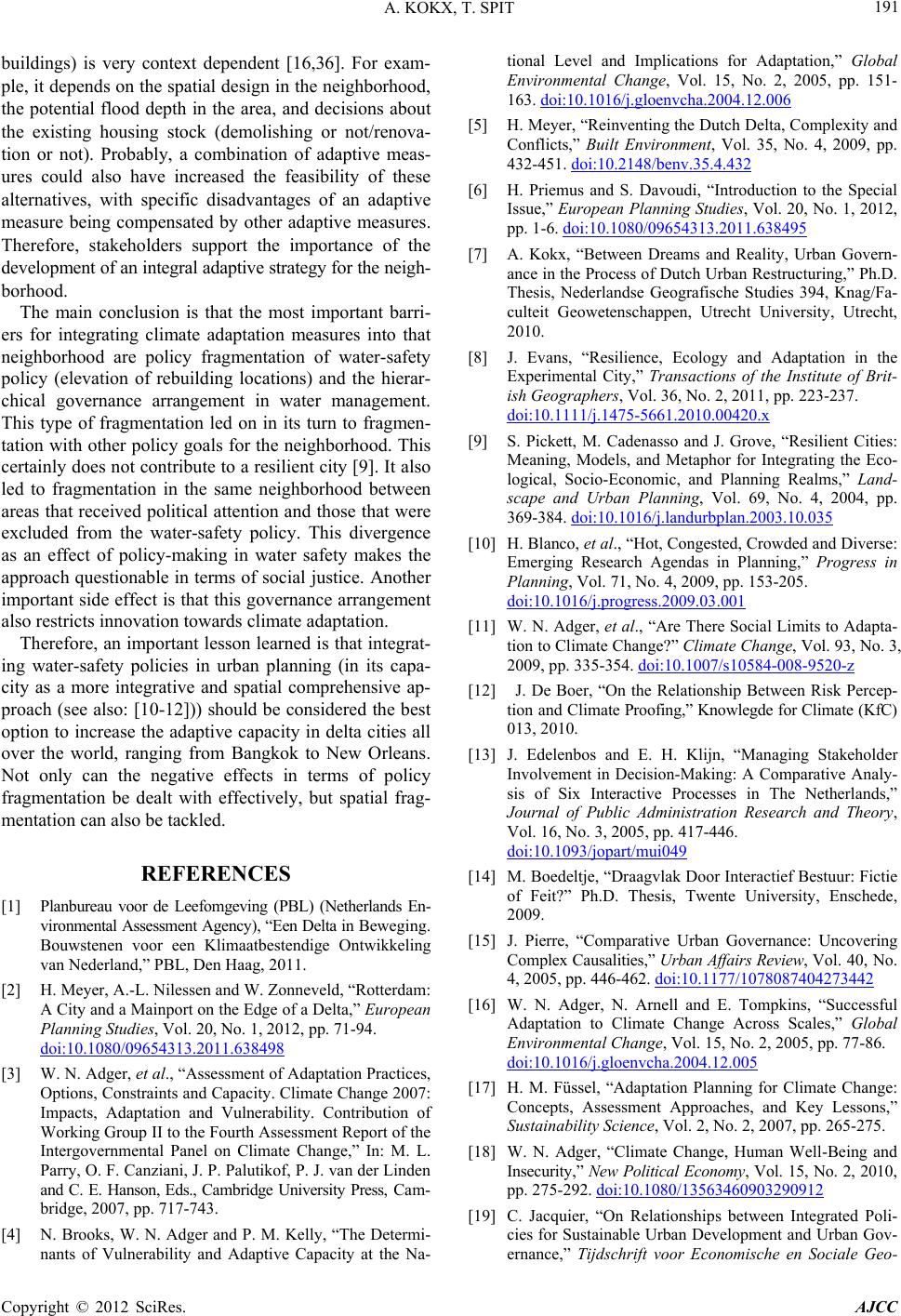 A. KOKX, T. SPIT 191 buildings) is very context dependent [16,36]. For exam- ple, it depends on the spatial design in the neighb orhood, the potential flood depth in the area, and decisions about the existing housing stock (demolishing or not/renova- tion or not). Probably, a combination of adaptive meas- ures could also have increased the feasibility of these alternatives, with specific disadvantages of an adaptive measure being compensated by other adaptive measures. Therefore, stakeholders support the importance of the development of an integral adaptive strategy for the neigh- borhood. The main conclusion is that the most important barri- ers for integrating climate adaptation measures into that neighborhood are policy fragmentation of water-safety policy (elevation of rebuilding locations) and the hierar- chical governance arrangement in water management. This type of fragmentation led on in its turn to fragmen- tation with other policy go als for the neighborhood. This certainly does not contribute to a resilient city [9]. It also led to fragmentation in the same neighborhood between areas that received political attention and those that were excluded from the water-safety policy. This divergence as an effect of policy-making in water safety makes the approach questionable in terms of social justice. Another important side effect is that this governance arrangement also restricts innovation towards climate adaptation. Therefore, an important lesson learned is that integrat- ing water-safety policies in urban planning (in its capa- city as a more integrative and spatial comprehensive ap- proach (see also: [10-12])) should be considered the best option to increase the adaptive capacity in delta cities all over the world, ranging from Bangkok to New Orleans. Not only can the negative effects in terms of policy fragmentation be dealt with effectively, but spatial frag- mentation can al so be tackl ed. REFERENCES [1] Planbureau voor de Leefomgeving (PBL) (Netherlands En- vironmental Assessment Agency ), “Een Delta in B ew e gi n g. Bouwstenen voor een Klimaatbestendige Ontwikkeling van Nederland,” PBL, Den Haag, 2011. [2] H. Meyer, A.-L. Nilessen and W. Zonneveld, “Rotterdam: A City and a Mainport on the Edge of a Delta,” European Planning Studies, Vol. 20, No. 1, 2012, pp. 71-94. doi:10.1080/09654313.2011.638498 [3] W. N. Adger, et al., “Assessment of Adaptation Practices, Options, Constraints and Capacity. Climate Change 2007: Impacts, Adaptation and Vulnerability. Contribution of Working Group II to the Fourth Assessment Report of the Intergovernmental Panel on Climate Change,” In: M. L. Parry, O. F. Ca nziani, J. P. Pa lutikof, P. J. van der Li nden and C. E. Hanson, Eds., Cambridge University Press, Ca m- bridge, 2007, pp. 717-743. [4] N. Brooks, W. N. Adger and P. M. Kelly, “The Determi- nants of Vulnerability and Adaptive Capacity at the Na- tional Level and Implications for Adaptation,” Global Environmental Change, Vol. 15, No. 2, 2005, pp. 151- 163. doi:10.1016/j.gloenvcha.2004.12.006 [5] H. Meyer, “Reinventing the Dutch Delta, Complexity and Conflicts,” Built Environment, Vol. 35, No. 4, 2009, pp. 432-451. doi:10.2148/benv.35.4.432 [6] H. Priemus and S. Davoudi, “Introduction to the Special Issue,” European Planning Studies, Vol. 20, No. 1, 2012, pp. 1-6. doi:10.1080/09654313.2011.638495 [7] A. Kokx, “Between Dreams and Reality, Urban Govern- ance in the Process of Dutch Urban Restructuring,” Ph.D. Thesis, Nederlandse Geografische Studies 394, Knag/Fa- culteit Geowetenschappen, Utrecht University, Utrecht, 2010. [8] J. Evans, “Resilience, Ecology and Adaptation in the Experimental City,” Transactions of the Institute of Brit- ish Geographers, Vol. 36, No. 2, 2011, pp. 223-237. doi:10.1111/j.1475-5661.2010.00420.x [9] S. Pickett, M. Cadenasso and J. Grove, “Resilient Cities: Meaning, Models, and Metaphor for Integrating the Eco- logical, Socio-Economic, and Planning Realms,” Land- scape and Urban Planning, Vol. 69, No. 4, 2004, pp. 369-384. doi:10.1016/j.landurbplan.2003.10.035 [10] H. Blanco, et al., “Hot, Congested, Crowded and Diverse: Emerging Research Agendas in Planning,” Progress in Planning, Vol. 71, No. 4, 2009, pp. 153-205. doi:10.1016/j.progress.2009.03.001 [11] W. N. Adger, et al., “Are There Social Limits to Adapta- tion to Climate Change?” Climate Change, Vol. 93, No. 3, 2009, pp. 335-354. doi:10.1007/s10584-008-9520-z [12] J. De Boer, “On the Relationship Between Risk Percep- tio n an d Cli mate Proofing,” Knowlegde for Climate (KfC) 013, 2010. [13] J. Edelenbos and E. H. Klijn, “Managing Stakeholder Involvement in Decision-Making: A Comparative Analy- sis of Six Interactive Processes in The Netherlands,” Journal of Public Administration Research and Theory, Vol. 16, No. 3, 2005, pp. 417-446. doi:10.1093/jopart/mui049 [14] M. Boedeltje, “Draagvlak Door Interactief Bestuur: Fictie of Feit?” Ph.D. Thesis, Twente University, Enschede, 2009. [15] J. Pierre, “Comparative Urban Governance: Uncovering Com plex Causalities,” Urban Affairs Review, Vol. 40, No. 4, 2005, pp. 446-462. doi:10.1177/1078087404273442 [16] W. N. Adger, N. Arnell and E. Tompkins, “Successful Adaptation to Climate Change Across Scales,” Global Environmental Change, Vol. 15, No. 2, 2005, pp. 77-86. doi:10.1016/j.gloenvcha.2004.12.005 [17] H. M. Füssel, “Adaptation Planning for Climate Change: Concepts, Assessment Approaches, and Key Lessons,” Sustainability Science, Vol. 2, No. 2, 2007, pp. 265-275. [18] W. N. Adger, “Climate Change, Human Well-Being and Insecurity,” New Political Economy, Vol. 15, No. 2, 2010, pp. 275-292. doi:10.1080/13563460903290912 [19] C. Jacquier, “On Relationships between Integrated Poli- cies for Sustainable Urban Development and Urban Gov- ernance,” Tijdschrift voor Economische en Sociale Geo- Copyright © 2012 SciRes. AJCC 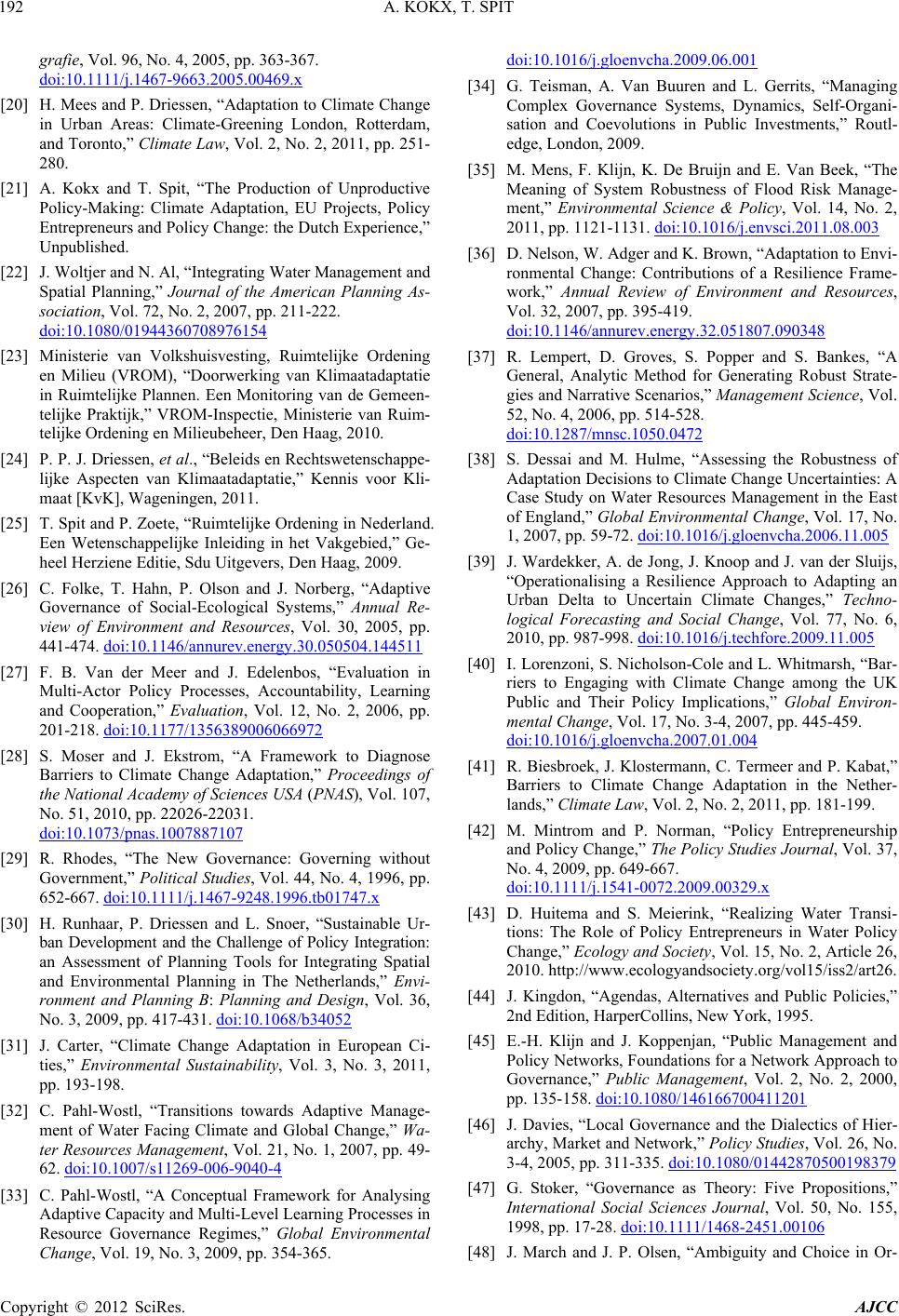 A. KOKX, T. SPIT 192 grafie, Vol. 96, No. 4, 2005, pp. 363-367. doi:10.1111/j.1467-9663.2005.00469.x [20] H. Mees and P. Driessen, “Adaptation to Climate Change in Urban Areas: Climate-Greening London, Rotterdam, and Toronto,” Climate Law, Vol. 2, No. 2, 2011, pp. 251- 280. [21] A. Kokx and T. Spit, “The Production of Unproductive Policy-Making: Climate Adaptation, EU Projects, Policy Entrepreneurs and Policy Change: the Dutch Experience,” Unpublished. [22] J. Woltjer and N. Al, “Integrating Water Management and Spatial Planning,” Journal of the American Planning As- sociation, Vol. 72, No. 2, 2007, pp. 211-222. doi:10.1080/01944360708976154 [23] Ministerie van Volkshuisvesting, Ruimtelijke Ordening en Milieu (VROM), “Doorwerking van Klimaatadaptatie in Ruimtelijke Plannen. Een Monitoring van de Gemeen- telijke Praktijk,” VROM-Inspectie, Ministerie van Ruim- telijke Ordening en Milieubeheer, Den Haag, 2010. [24] P. P. J. Driesse n, et al., “Beleids en Rechtswetenschappe- lijke Aspecten van Klimaatadaptatie,” Kennis voor Kli- maat [KvK], Wageningen, 2011. [25] T. Spit and P. Zoete, “Ruimtelijke Ordening in Nederland. Een Wetenschappelijke Inleiding in het Vakgebied,” Ge- heel Herziene Editie, Sdu Uitgevers, Den Haag, 2009. [26] C. Folke, T. Hahn, P. Olson and J. Norberg, “Adaptive Governance of Social-Ecological Systems,” Annual Re- view of Environment and Resources, Vol. 30, 2005, pp. 441-474. doi:10.1146/annurev.energy.30.050504.144511 [27] F. B. Van der Meer and J. Edelenbos, “Evaluation in Multi-Actor Policy Processes, Accountability, Learning and Cooperation,” Evaluation, Vol. 12, No. 2, 2006, pp. 201-218. doi:10.1177/1356389006066972 [28] S. Moser and J. Ekstrom, “A Framework to Diagnose Barriers to Climate Change Adaptation,” Proceedings of the National Academy of Sciences USA (PNAS), Vol. 107, No. 51, 2010, pp. 22026-22031. doi:10.1073/pnas.1007887107 [29] R. Rhodes, “The New Governance: Governing without Government,” Political Studies, Vol. 44, No. 4, 1996, pp. 652-667. doi:10.1111/j.1467-9248.1996.tb01747.x [30] H. Runhaar, P. Driessen and L. Snoer, “Sustainable Ur- ban Development and the Challenge of Policy Integration: an Assessment of Planning Tools for Integrating Spatial and Environmental Planning in The Netherlands,” Envi- ronment and Planning B: Planning and Design, Vol. 36, No. 3, 2009, pp. 417-431. doi:10.1068/b34052 [31] J. Carter, “Climate Change Adaptation in European Ci- ties,” Environmental Sustainability, Vol. 3, No. 3, 2011, pp. 193-198. [32] C. Pahl-Wostl, “Transitions towards Adaptive Manage- ment of Water Facing Climate and Global Change,” Wa- ter Resources Management, Vol. 21, No. 1, 2007, pp. 49- 62. doi:10.1007/s11269-006-9040-4 [33] C. Pahl-Wostl, “A Conceptual Framework for Analysing Adaptive Capacity and Multi-Level Learning Processes in Resource Governance Regimes,” Global Environmental Change, Vol. 19, No. 3, 2009, pp. 354-365. doi:10.1016/j.gloenvcha.2009.06.001 [34] G. Teisman, A. Van Buuren and L. Gerrits, “Managing Complex Governance Systems, Dynamics, Self-Organi- sation and Coevolutions in Public Investments,” Routl- edge, London, 2009. [35] M. Mens, F. Klijn, K. De Bruijn and E. Van Beek, “The Meaning of System Robustness of Flood Risk Manage- ment,” Environmental Science & Policy, Vol. 14, No. 2, 2011, pp. 1121-1131. doi:10.1016/j.envsci.2011.08.003 [36] D. Nelson, W. Adger and K. Brown, “Adaptation to Envi- ronmental Change: Contributions of a Resilience Frame- work,” Annual Review of Environment and Resources, Vol. 32, 2007, pp. 395-419. doi:10.1146/annurev.energy.32.051807.090348 [37] R. Lempert, D. Groves, S. Popper and S. Bankes, “A General, Analytic Method for Generating Robust Strate- gies and Narrative Scenarios,” Management Science, Vol. 52, No. 4, 2006, pp. 514-528. doi:10.1287/mnsc.1050.0472 [38] S. Dessai and M. Hulme, “Assessing the Robustness of Adaptation Decisions to Climate Change Uncertainties: A Case Study on Water Resources Management in the East of Engl and,” Global Environmental Change, Vol. 17, No. 1, 2007, pp. 59-72. doi:10.1016/j.gloenvcha.2006.11.005 [39] J. Wardekker, A. de Jong, J. Knoop and J. van der Sluijs, “Operationalising a Resilience Approach to Adapting an Urban Delta to Uncertain Climate Changes,” Techno- logical Forecasting and Social Change, Vol. 77, No. 6, 2010, pp. 987-998. doi:10.1016/j.techfore.2009.11.005 [40] I. Lorenzoni, S. Nicholson-Cole and L. Whitmarsh, “Bar- riers to Engaging with Climate Change among the UK Public and Their Policy Implications,” Global Environ- mental Change, Vol. 17, No. 3-4, 2007, pp. 445-459. doi:10.1016/j.gloenvcha.2007.01.004 [41] R. Biesbroek, J. Klostermann, C. Termeer and P. Kabat,” Barriers to Climate Change Adaptation in the Nether- lands,” Climate Law, Vol. 2, No. 2, 2011, pp. 181-199. [42] M. Mintrom and P. Norman, “Policy Entrepreneurship and Policy Change,” The Policy Studies Journal, Vol. 37, No. 4, 2009, pp. 649-667. doi:10.1111/j.1541-0072.2009.00329.x [43] D. Huitema and S. Meierink, “Realizing Water Transi- tions: The Role of Policy Entrepreneurs in Water Policy Change,” Ecology and Society, Vol. 15, No. 2, Article 26, 2010. http://www.ecologyandsociety.org/vol15/iss2/art26. [44] J. Kingdon, “Agendas, Alternatives and Public Policies,” 2nd Edition, HarperCollins, New York, 1995. [45] E.-H. Klijn and J. Koppenjan, “Public Management and Policy Networks, Foundations for a Network Approach to Governance,” Public Management, Vol. 2, No. 2, 2000, pp. 135-158. doi:10.1080/146166700411201 [46] J. Davies, “Local Governance and the Dialectics of Hier- archy, Market and Network,” Policy Studies, Vol. 26, No. 3-4, 2005, pp. 311-335. doi:10.1080/01442870500198379 [47] G. Stoker, “Governance as Theory: Five Propositions,” International Social Sciences Journal, Vol. 50, No. 155, 1998, pp. 17-28. doi:10.1111/1468-2451.00106 [48] J. March and J. P. Olsen, “Ambiguity and Choice in Or- Copyright © 2012 SciRes. AJCC 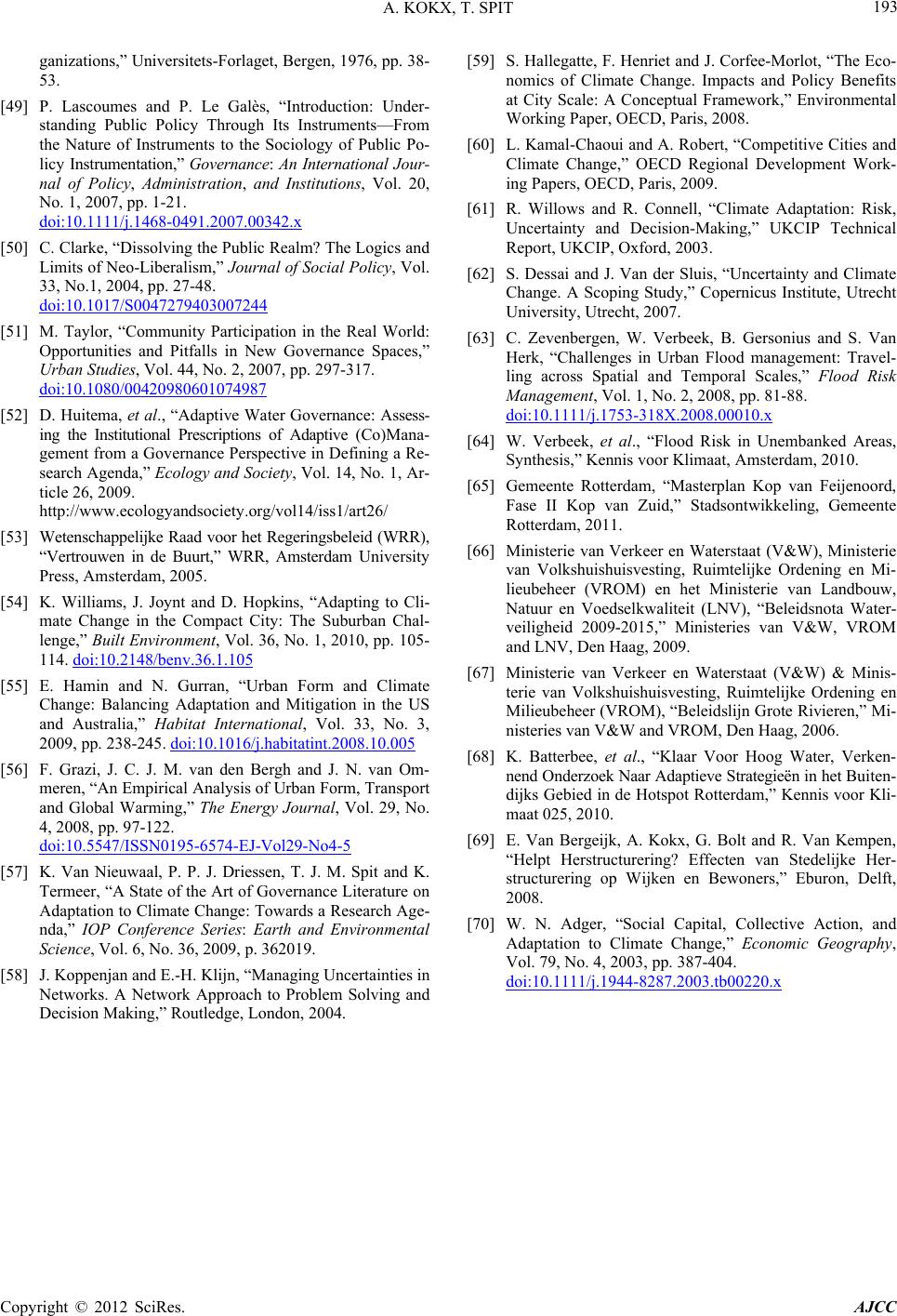 A. KOKX, T. SPIT Copyright © 2012 SciRes. AJCC 193 ganizations,” Universitets-Forlaget, Bergen, 1976, pp. 38- 53. [49] P. Lascoumes and P. Le Galès, “Introduction: Under- standing Public Policy Through Its Instruments—From the Nature of Instruments to the Sociology of Public Po- licy Instrumentation,” Governance : An International Jour- nal of Policy, Administration, and Institutions, Vol. 20, No. 1, 2007, pp. 1-21. doi:10.1111/j.1468-0491.2007.00342.x [50] C. Clarke, “Dissolving the Public Realm? The Logics and Limits of Neo-Liberalism,” Journal of Social Policy, Vol. 33, No.1, 2004, pp. 27-48. doi:10.1017/S0047279403007244 [51] M. Taylor, “Community Participation in the Real World: Opportunities and Pitfalls in New Governance Spaces,” Urban Studies, Vol. 44, No. 2, 2007, pp. 297-317. doi:10.1080/00420980601074987 [52] D. Huitema, et al., “Adapt ive Water Governance: Assess- ing the Institutional Prescriptions of Adaptive (Co)Mana- gement from a Governance Perspective in Defining a Re- search Agenda,” Ecology and Society, Vol. 14, No. 1, Ar- ticle 26, 2009. http://www.ecologyandsociety.org/vol14/iss1/art26/ [53] Wetenschappelijke Raad voor het Regeringsbeleid (WRR), “Vertrouwen in de Buurt,” WRR, Amsterdam University Press, Amsterdam, 2005. [54] K. Williams, J. Joynt and D. Hopkins, “Adapting to Cli- mate Change in the Compact City: The Suburban Chal- lenge,” Built Environment, Vol. 36, No. 1, 2010, pp. 105- 114. doi:10.2148/benv.36.1.105 [55] E. Hamin and N. Gurran, “Urban Form and Climate Change: Balancing Adaptation and Mitigation in the US and Australia,” Habitat International, Vol. 33, No. 3, 2009, pp. 238-245. doi:10.1016/j.habitatint.2008.10.005 [56] F. Grazi, J. C. J. M. van den Bergh and J. N. van Om- meren, “An Empirical Analysis of Urban Form, Transport and Global Warming,” The Energy Journal, Vol. 29, No. 4, 2008, pp. 97-122. doi:10.5547/ISSN0195-6574-EJ-Vol29-No4-5 [57] K. Van Nieuwaal, P. P. J. Driessen, T. J. M. Spit and K. Termeer, “A Stat e of the Art of Governance Literature on Adaptation to Climate Change: Towards a Research Age- nda,” IOP Conference Series: Earth and Environmental Science, Vol. 6, No. 36, 2009, p. 362019. [58] J. Koppenjan and E.-H. Klijn, “Managing Uncertainties in Networks. A Network Approach to Problem Solving and Decision Making,” Routledge, London, 2004. [59] S. Halleg atte, F. Henriet and J. Corfee-Morlot, “The Eco- nomics of Climate Change. Impacts and Policy Benefits at City Scale: A Conceptual Framework,” Environmental Working Paper, OECD, Paris, 2008. [60] L. Kamal-Chaoui and A. Robert, “Competitive Cities and Climate Change,” OECD Regional Development Work- ing Papers, OECD, Paris, 2009. [61] R. Willows and R. Connell, “Climate Adaptation: Risk, Uncertainty and Decision-Making,” UKCIP Technical Report, UKCIP, Oxford, 2003. [62] S. Dessai and J. Van der Sluis, “Uncertainty and Climate Change. A Scoping Study,” Copernicus Institute, Utrecht University, Utrecht, 2007. [63] C. Zevenbergen, W. Verbeek, B. Gersonius and S. Van Herk, “Challenges in Urban Flood management: Travel- ling across Spatial and Temporal Scales,” Flood Risk Management, Vol. 1, No. 2, 2008, pp. 81-88. doi:10.1111/j.1753-318X.2008.00010.x [64] W. Verbeek, et al., “Flood Risk in Unembanked Areas, Synthesis,” Kennis voor Klimaat, Amsterdam, 2010. [65] Gemeente Rotterdam, “Masterplan Kop van Feijenoord, Fase II Kop van Zuid,” Stadsontwikkeling, Gemeente Rotterdam, 2011. [66] Ministerie van Verkeer en Waterstaat (V&W), Ministerie van Volkshuishuisvesting, Ruimtelijke Ordening en Mi- lieubeheer (VROM) en het Ministerie van Landbouw, Natuur en Voedselkwaliteit (LNV), “Beleidsnota Water- veiligheid 2009-2015,” Ministeries van V&W, VROM and LNV, Den Haag, 2009. [67] Ministerie van Verkeer en Waterstaat (V&W) & Minis- terie van Volkshuishuisvesting, Ruimtelijke Ordening en Milieubeheer (VROM), “Beleidslijn Grote Rivieren,” Mi- nisteries van V&W and VROM, Den Haag, 2006. [68] K. Batterbee, et al., “Klaar Voor Hoog Water, Verken- nend Onderzoek Naar Adaptieve Strategieën in het B ui te n - dijks Gebied in de Hotspot Rotterdam,” Kennis voor Kli- maat 025, 2010. [69] E. Van Bergeijk, A. Kokx, G. Bolt and R. Van Kempen, “Helpt Herstructurering? Effecten van Stedelijke Her- structurering op Wijken en Bewoners,” Eburon, Delft, 2008. [70] W. N. Adger, “Social Capital, Collective Action, and Adaptation to Climate Change,” Economic Geography, Vol. 79, No. 4, 2003, pp. 387-404. doi:10.1111/j.1944-8287.2003.tb00220.x
|